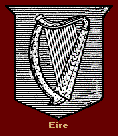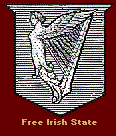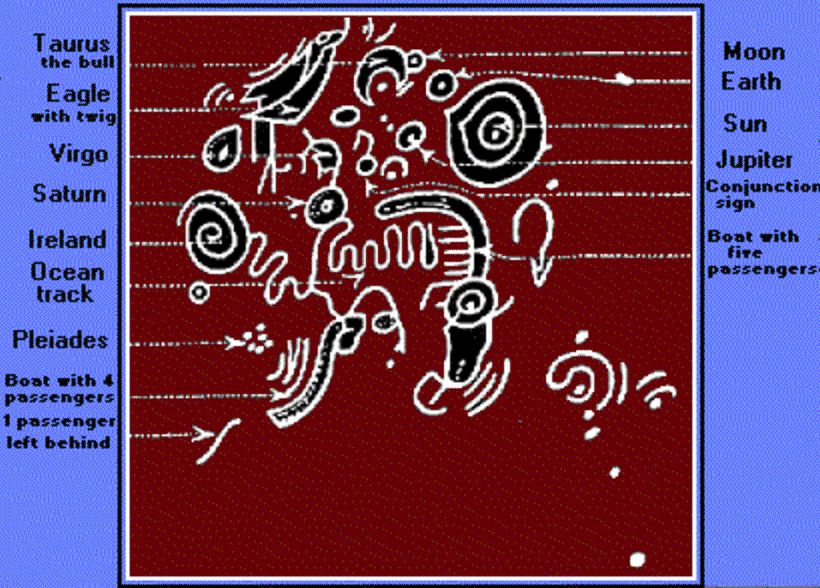JEREMIAH


AND
TEA TEPHI
________________________________________________________
Jeremiah's voyage
Poem of Tea Tephi
________________________________________________________
JEREMIAH'S VOYAGE
An old man arrives on an Island with a small group of people in 583 BC.
He brings the daughter of a King, a scribe named Simon Brug and some
relics. The powerful Milesian High King of all Ireland allows the old
man complete control. Instituting laws, schools and congresses, the
old man forever changes the face of the Island's history, and subsequently
the history of the entire world. Apparently incidental to all this, is the
fulfilling of a 500 year old prophecy.
Few people know that Jeremiah was much more than a prophet. He tends
to get lumped in with Isaiah, Ezekial, and the others. Jeremiah did
more than go around speaking doom and gloom. He held a high
level position in the kingdom of Judah. He was the grandfather of King
Zedekiah. II Kings 24:18. Most importantly, Jeremiah was God's Trustee
of the Bloodline and the Throne of David.
Jeremiah's commission has always puzzled scholars. One can find where Jeremiah
rooted out, pulled down, destroyed, and threw down kingdoms. History
shows that his prophecies about the destruction of kingdoms came true. The
mystery is, where did Jeremiah "build and plant?" The scriptural account
doesn't contain any building and planting. There is also some confusion about
Jeremiah's being put "over the nations." It would appear at first glance
that this meant his prophesying against them. This is not the case. First,
Jer 1:10 says that God set him "over the nations, not nations
(in general). This is repeated with the word kingdoms; the kingdoms.
The bible is concerned with only one people, the twelve tribes of Israelites.
Jeremiah was to "throw down" AND "build and plant"
the Israelite nations. We'll have to follow his trail to find where
he accomplished his mission.
First we'll look at the Biblical account. Jer 15:11-14 tells us Jerry is going
to a brand new place he "knowest not." Isaiah fills out the picture a bit.
Isaiah 41:1-3 tells us that a "righteous man from the east" was put over
nations and kings. This man would not travel by foot ( on land). Jer 41:10
establishes the presence of the "king's daughters" in the group with Jeremiah.
Jeremiah, as their great-grandfather, would certainly have assumed the
postion of Guardian.Then we find Jeremiah and the girls going to the Egyptian
city of Tahpanhes. In fact, there is an ancient structure there that bears
the name, "Palace of the Jew's daughters." Isaiah helps us again with a last
bit of confirmation, in chapter 37:31, telling us that a "remnant of
Judah" shall escape and "take root downward."
Before going on, we must take notice of what God had promised Jeremiah and his
fellow travelers. God told Jeremiah that he'd be treated kindly by the
Babylonians and die a natural death. Baruch, Jeremiah's scribe and Ebed-Melech,
the Ethiopian, are also told they'd be spared. The probable number in Jeremiah's
traveling band was five: Jeremiah, Baruch, Ebed-Melech Tea Tephi and her
sister.
It's not so hard to trace the migration of large groups of people. Not so with
small groups. But God knows this too, and has left evidence that we may overcome
our doubts about Jeremiah's destination. But we have to go the history books.
Only one place in the world claims to have the grave of the prophet Jeremiah.
Only one country's history tells of an old man, and his scribe Brug bringing a
king's daughter from Egypt. Only one country claims the Harp of David for it's
Arms. Only one country has Jerrys coming out of it's ears.
IRELAND.
Although, due to the Bards embellishing the story, accounts of Jeremiah's arrival
and work in Ireland differ in some details, the basic elements of each tale
are the same.
- The Stone, known as the "Stone of Destiny" came from Spain,
- and before that, from Egypt
- It came in the company of an aged guardian, who was called
"Ollam Folla", (Hebrew for revealer or prophet)
- Accompanying the man was an eastern king's daughter
- Eochaidh (Eremhon) married the daughter, Tea Tephi
- The aged guardian became the most influencial Statesman
and Spiritual leader of Ireland.
Remember the evidence I mentioned, that God would supply us to confirm
Jeremiah's trip? The following picture is of an inscription found in a
tomb located in Schiabhla-Cailliche, near Oldcastle, County, Meath, Ireland,
not far from Tara. Thirty-some stones with strange markings upon them, lie
in the sepulchral chamber within the huge cairn of stones which make up
the tomb. A large carved stone outside the tomb is till pointed out as
Jeremiah's judicial seat. Our confirmation lies on those thirty stones
in the cairn.
One interperation, by George Dansie of Bristol, says the the stones show a
Lunar Eclipse, in the constellation of Taurus and a conjunction of the
planets Saturn and Jupiter in Virgo. The prow of a ship is shown in the
center, with five lines indicating the number of passengers it carries.
On the left, a part of the ship, perhaps the stern, is shown with only
four passengers, one having been left behind, as indicated by the line
falling away from the ship. The wavy line indicates the passage of the
ship across the ocean, terminating at a central point on an island.
The stellar and planetary alignment of the inscription gives a date
of 583 BC. This date allows just the right amount of time for our little
band to go to Egypt, and return to Palestine briefly before making their
way to Spain, then Ireland.

THE
VOYAGE
OF THE
TRAVELLING
TRUSTEE
________________________________________________________
TEA TEPHI
Buried ineradically in the poetry and folk-lore of Ireland is the tale of a Prophet, an Egyptian Princess and Simon Brug (Baruch) a Scribe. They Landed in Ireland about the same time that the destruction of Jerusalem took place, bearing with them a great chest and a stone wrapped on a banner. The Princess married the Zarahite King, Eochaidh II. Ard-dath, Ard-righ, or Heremon (horse man of all Ireland), and their son was Irial. I, (M.R. Munro Faure) give quotations from old Irish verse:
The praises of Tea Tephi, daughter of Lughaidh (equivalent in Erse of Bethel) are sung as:
"The Beautiful One with a Royal Prosperous Smile."
"Tephi (Hebrew beautiful) the most beautiful that traversed the Plain."
"Temor of Bregia, whence so called."
Relate to me O learned Sages,
When was the place called Temor?
Was it in the time of Parthalon of battles?
Or at the first arrival of Caesaire?
Tell me in which of these invasions
Did the place have the name of Tea-mor?
O Tuan, O generous Finchadh,
O Dubhan, Ye venerable Five
Whence was acquired the name of Te-mor?
Until the coming of the agreeable Teah
The wife of Heremon of noble aspect.
A Rampart was raised around her house
For Teah the daughter of Lughaidh (God's House)
She was buried outside in her mound
And from her it was named Tea-muir.
Cathair, Crofin not inapplicable.
Was its name among the Tuatha-de-Danaan
Until the coming of Tea - the Just
Wife of Heremon of the noble aspect?
A wall was raised around her house
For Tea the daughter of Lughaidh,
(And) she was interred in her wall outside,
So that from her is Tea-mor.
A habitation which was a Dun (Hebrew court) and a fortress
Which was the glory of murs without demolition,
On which the monument of Tea after her death,
So that it was an addition to her dowry.
The humble Heremon had
A woman in beautiful confinement
Who received from him everything she wished for.
He gave her whatever he promised,
Bregatea a meritorious abode
(Where lies) The grave, which is the great Mergech (Hebrew burial place)
The burial place which was not violated.
The daughter of Pharaoh of many champions
Tephi, the most beautiful that traversed the Plain.
She gave a name to her fair cahir,
The woman with the prosperous royal smile,
Mur-Tephi where the assembly met.
It is not a mystery to be said
A Mur (was raised) over Tephi I have heard.
Strength this, without contempt,
Which great proud Queen have formed
The length, breadth of the house of Tephi,
Sixty feet without weakness
As Prophets and Druids have seen.
From "Forward" - Watchman What of the Dawn
________________________________________________________
Return to Lost Tribes Subject List.
__________________________________________________
___________________________________________________________________
I love mail.

Come
Home




